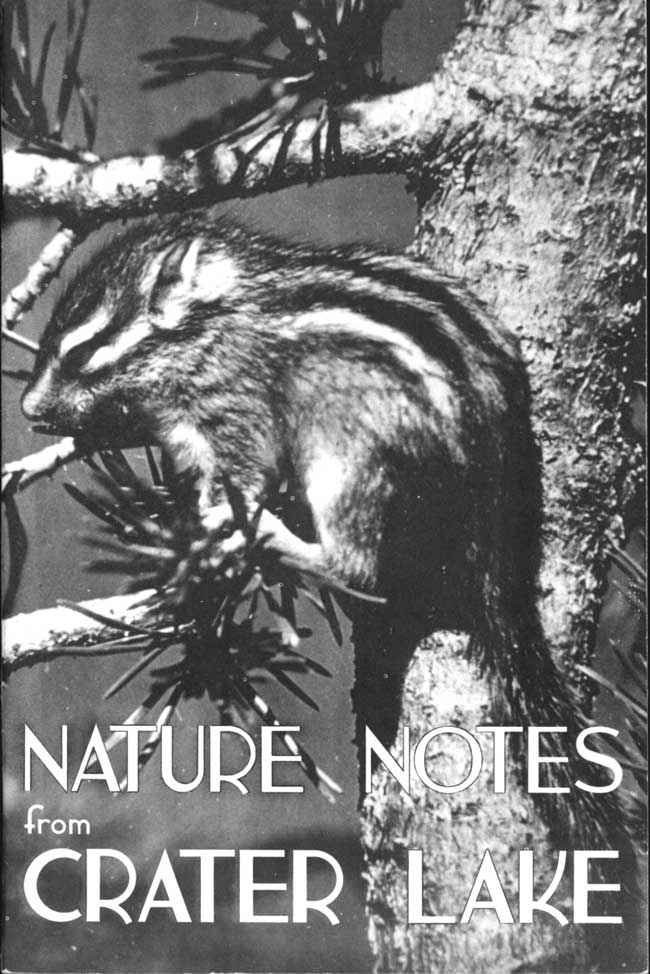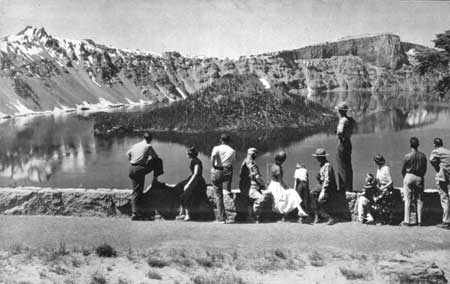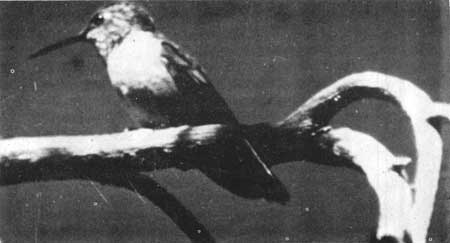Volume 20 page 1, 1954
All material courtesy of the National Park Service.These publications can also be found at http://npshistory.com/
Nature Notes is produced by the National Park Service. © 1954
Introduction
In line with one of the objects of the Crater Lake Natural History Association, namely, “to aid in the distribution of information on all subjects pertaining to the park”, this 1954 number of CRATER LAKE NATURE NOTES is offered to the public. Reprinting of articles appearing in this publication is encouraged. It is requested that acknowledgment of the source be made by giving the name of the author and of this magazine.
A dedicated National Park Service naturalist staff has presented a very successful program of talks, field trips, exhibits and other informational service in the park during the past summer. The material presented herein is the result of activities on the part of the staff which are seldom brought to the notice of the public — the gathering of new information about your park. The results of such efforts serve to document the talks, exhibits and other presentations by the naturalists to the public.
The Crater Lake Natural History Association was founded in 1942 to promote and assist the naturalist program offered the public in the park, to further the investigation of subjects of popular interest and importance and to aid in the distribution of information on all subjects pertaining to the park. Toward this end it sponsors CRATER LAKE NATURE NOTES and operates a publications sales counter, the proceeds from which are used entirely to support this work. A list of items for sale may be obtained by writing to the Executive Secretary, Crater Lake Natural History Association, Box 97, Crater Lake, Oregon.
Bears are Wild Animals
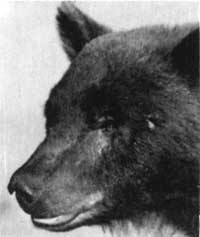 Photo by Welles & Welles |
“Where can we see a bear? ” is one of the most frequent questions at Crater Lake National Park, and there is a good reason. Among the informative leaflets given those entering the park is one that says, “PARK BEARS and other animals are WILD.” This and similar posters greet them at every bulletin board in the park, and the theme is repeated by Rangers during the day.
According to Roland D. Walters (1953. Observations and census of the black bear in Crater Lake National Park. Nature Notes from Crater Lake 19:26-28), there are about forty-one bears that make their homes here. About half are adults over two years old. The brown and black color phases are more or less equally represented in all ages. All of these are Olympic black bears, Ursus americanus altifrontalis(Elliot). Most of the bears avail themselves of the garbage left by picnickers in the campground containers and other refuse cans located elsewhere around the park.
Anyone who stays in a campground can see a bear — by flashlight! And he can tell about the one that interrupted his sleep, because bruin made quite a racket during his rounds of the garbage cans, his nose tempting him into trouble. The next morning the careless camper finds opened, or carried away, such items as tin cans and sugar sacks. Usually at least one ice box has been broken into.
The artificial source of food sometimes brings a few bears into view in daylight. But unless they are fed purposely, they remain shy of humans and, consequently, out of trouble. Members of the National Park Service hope that bears in our parks can be persuaded to give up panhandling and earn their own living again.
In this park, continual vigilance is maintained in order to detect bears which presume upon cars or people as a source of food, a practice which they have no doubt learned from some one of the minority of visitors who disregard the warnings and slip “cutie cub” his first tidbit. Trapping and removing dangerous bears to remote areas of the park, or the extreme necessity of destroying one of these animals, are undesirable tasks for the personnel here dedicated to preserve life. We must endeavor also, however, to safeguard the life of the indulgent visitor and of the law-abiding one who might follow to suffer from the actions of an artificially fed bear.
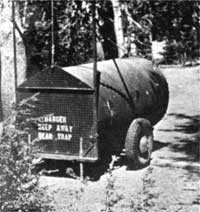 Bear Trap Closed From Kodachrome by John Mees |
This year a happy exception to the rule was one of two yearling cubs which appeared long before the Rim Campground opened. They panhandled along the road, but were often chased by rangers throwing rocks to discourage them. As the summer developed, one was seldom seen by visitors after the middle of July. To my surprise one morning, instead of seeing him begging beside the road, I found him digging out ants and other natural foods from a rotten stump near Goodbye Bridge.
Fate was less kind to the other cub. A porcupine rewarded his curiosity — or hunger — with a nose full of quills. Early attempts to catch him and remove the quills failed, and by the time he was caught, his temper had grown short and his coat shabby. More time was spent at the campgrounds looking for easy food. Of course he was fed and chased, photographed and teased — until he became intolerant and would bristle his coat and snarl.
One day he argued with the garbage collector over who should have the garbage. He had been caught twice before in the bear trap, but this time he was taken to the far northeastern corner of the park. There he was turned loose and encouraged not to come back. The temptation was too strong, however, for he was back in two days. We hope that his boldness is at least subdued, so that no extreme measures have to be taken.
During mating season this year, the male bears displayed unusual excitement by stamping their front feet when humans were near. One three-year-old male surprised the garbage collector by swatting at him, for no apparent reason, tearing open the back of his hand. This is the only human injury caused by bears in the park so far this season. The park policy of making the visitors aware and warned of bear traits is definitely paying off.
Bill Rosenbalm, who has worked with the garbage truck for three years, has noticed about twelve new cubs this year: four pairs of twins, one single and a healthy set of triplets, two of which are black and one is brown.
One interesting antic he reports is that of a large bear which rolled a garbage can some twenty or thirty yards away from the garbage truck by backing away and pawing it toward himself.
Bears are wild animals. Feeding them is an infringement of park regulations. But more than this, such actions are not easily reconciled to the bear’s natural existence, which must be maintained for complete freedom on the part of these animals and for us who would like to observe them. We therefore hope that you will help to establish this situation by resisting temptation.
Unusual Eagle Experiences
On July 23, 1954, while I was on duty in Sinnott Memorial, a bald eagle, Haliacetus leucocephalus (Linnaeus), was observed in the water approximately 20 yards from the shore to the east of the viewpoint. Using field glasses, I could see the eagle moving through the water with the aid of his wings. I could not see whether or not the eagle had a fish in his talons and do not know how it got into the water.
After the eagle reached shore it flew into a nearby tree, where it stayed for about a half-hour. Later it was seen soaring above the rim of the lake. Dr. D. S. Farner (1952. The Birds of Crater Lake National Park. University of Kansas Press. xi, 187 pp.) mentions a similar incident.
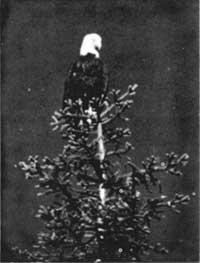 Bald Eagle From Kodachrome by Welles & Welles |
On August 7, 1954, A. E. O’Nion of Danville, California, brought to my attention an unusual incident which happened while he was fishing from a rowboat on the lake. A short distance from him was another party of fishermen. One of the members of this party hooked a small fish, apparently in the eye. All eyes were turned toward the man showing his skill at catching the first fish of the day and were watching him reeling in the line with his prize.
Nobody noticed a bald eagle, soaring above, which had spotted with its keen eyes a crippled fish in the clear blue water below. When the fish broke the surface of the water the eagle swooped down over the water in a dive, grasped the fish in its talons when it was only a few feet from the boat and flew away to a nearby tree. Needless, to say, the fishermen were surprised — even dumbfounded — by such a strange experience. They went home empty-handed as far as fish were concerned, but with an unusual fish story.
Hummingbird Antics
Just a few dozen yards below the summit of Garfield Peak I was startled by a sudden swoosh and a shrill note as a streak went by only a few feet in front of my head. I had just finished planting a flower marker sign on the trail to the top of Garfield Peak. It was Monday, August 16, at about 4:20 p.m.
I kept on hiking and once again – zoom – right in front of me swished the small blurred object! I watched as it arched into the air, turned and headed straight for me. This male hummingbird began a series of plunges from 40 or 50 feet up, emitting a sharp note at the bottom of the arc as he passed.
In early spring in Southern California I had watched and heard, on several occasions, the courtship flight of the male Anna hummingbird. He zooms high above the female and then darts down in an arc, making an explosive sound directly over her. But here I was near a mountaintop in the middle of August, very late in the season for any display of territorial behavior, and I have yet to be told I resemble a female hummingbird!
This kept up for about three minutes. Each zoom caused me to duck, even though I realized that the small object was only a tiny bird headed in my direction. Then he disappeared. I feel fairly certain that he was a rufous hummingbird, Selasphorus rufus(Gmelin). I wonder what he took me for?


